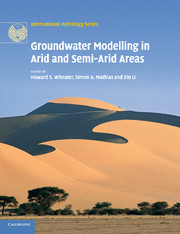Book contents
- Frontmatter
- Contents
- Contributors
- Preface
- Acknowledgements
- 1 Groundwater modelling in arid and semi-arid areas: an introduction
- 2 Hydrological processes, groundwater recharge and surface-water/groundwater interactions in arid and semi-arid areas
- 3 Conceptual models for recharge sequences in arid and semi-arid regions using isotopic and geochemical methods
- 4 Groundwater flow and transport
- 5 Performing unbiased groundwater modelling: application of the theory of regionalised variables
- 6 Groundwater vulnerability and protection
- 7 Variable density groundwater flow: from modelling to applications
- 8 Sustainable water management in arid and semi-arid regions
- Index
- Plate section
- References
4 - Groundwater flow and transport
Published online by Cambridge University Press: 06 December 2010
- Frontmatter
- Contents
- Contributors
- Preface
- Acknowledgements
- 1 Groundwater modelling in arid and semi-arid areas: an introduction
- 2 Hydrological processes, groundwater recharge and surface-water/groundwater interactions in arid and semi-arid areas
- 3 Conceptual models for recharge sequences in arid and semi-arid regions using isotopic and geochemical methods
- 4 Groundwater flow and transport
- 5 Performing unbiased groundwater modelling: application of the theory of regionalised variables
- 6 Groundwater vulnerability and protection
- 7 Variable density groundwater flow: from modelling to applications
- 8 Sustainable water management in arid and semi-arid regions
- Index
- Plate section
- References
Summary
INTRODUCTION
A model is an entity built to reproduce some aspect of the behaviour of a natural system. In the context of groundwater, aspects to be reproduced may include: groundwater flow (heads, water velocities, etc.); solute transport (concentrations, solute fluxes, etc.); reactive transport (concentrations of chemical species reacting among themselves and with the solid matrix, minerals dissolving or precipitating, etc.); multiphase flow (fractions of water, air, non-aqueous phase liquids, etc.); energy (soil temperature, surface radiation, etc.); and so forth.
Depending on the type of description of reality that one is seeking (qualitative or quantitative), models can be classified as conceptual or mathematical. A conceptual model is a qualitative description of ‘some aspect of the behaviour of a natural system’. This description is usually verbal, but may also be accompanied by figures and graphs. In the groundwater flow context, a conceptual model involves defining the origin of water (areas and processes of recharge) and the way it flows through and exits the aquifer. In contrast, a mathematical model is an abstract description (abstract in the sense that it is based on variables, equations and the like) of ‘some aspect of the behaviour of a natural system’. However, the motivation of mathematical models is not abstract, but to aid quantification. For example, a mathematical model of groundwater flow should yield the time evolution of heads and fluxes (water movements) at every point in the aquifer.
- Type
- Chapter
- Information
- Groundwater Modelling in Arid and Semi-Arid Areas , pp. 39 - 62Publisher: Cambridge University PressPrint publication year: 2010
References
- 3
- Cited by



